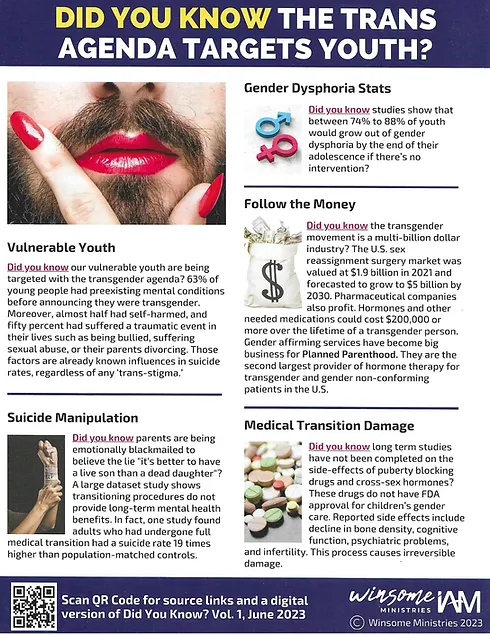Table of Contents
Introduction: The Targeting of Vulnerable Youth by the Transgender Agenda
The Rise in Transgender Identification Among Youth: A Growing Concern
In recent years, there has been a notable rise in the number of young people identifying as transgender, a trend that has sparked concern among parents, educators, and policymakers. This increase prompts critical questions about the underlying factors influencing these decisions, particularly among youth who may already be vulnerable due to preexisting mental health conditions or past traumatic experiences. As the number of transgender-identifying youth grows, it becomes increasingly important to understand the societal, cultural, and psychological influences at play. This understanding is essential for those who are committed to safeguarding the well-being of our youth and ensuring that decisions regarding gender identity are made with careful consideration and support.
Targeting the Vulnerable: The Impact of the Transgender Agenda on Youth
The surge in transgender identification among young people has led to growing concerns that the transgender agenda is disproportionately affecting vulnerable youth. Alarming statistics suggest that a significant portion of these young individuals had preexisting mental health conditions or traumatic experiences before coming out as transgender. This raises important questions about whether these youth are being adequately supported or if they are being guided towards life-altering decisions without fully understanding the long-term implications. By examining the broader context of this issue, it becomes clear that more research and dialogue are needed to protect vulnerable youth from potential harm and to ensure that their well-being is prioritized in any discussions about gender identity.

The Vulnerability of Youth and Preexisting Conditions
The Transgender Agenda and the Vulnerability of At-Risk Youth
Did you know that an astonishing 63% of young people who identify as transgender had preexisting mental health conditions before making their announcement? This statistic sheds light on the significant vulnerability of these youth, many of whom have already encountered severe challenges such as bullying, sexual abuse, or parental divorce. These traumatic experiences are known to elevate suicide risks, regardless of any “trans-stigma” they might face. The intersection of these hardships with gender identity issues raises concerns about the potential influence of the transgender agenda on these already at-risk individuals. The heightened susceptibility of these youth underscores the need for careful consideration of how the transgender agenda might be impacting their mental health and overall well-being.
The Transgender Agenda: Risks and Exploitation of Vulnerable Youth
The transgender agenda’s impact on vulnerable youth is especially concerning when considering that 63% of transgender-identifying young people had preexisting mental health issues before their announcement. Many have faced significant trauma, such as bullying, sexual abuse, and parental divorce—factors already linked to increased suicide risks. The intersection of these traumatic experiences with gender identity pressures raises serious concerns about potential exploitation by those promoting the transgender agenda. These vulnerable youth may be particularly susceptible to external influences that could worsen their mental health struggles. It is essential to critically examine how the transgender agenda affects these young people and ensure their protection and support.
Suicide Manipulation: Emotional Blackmail of Parents
The Transgender Agenda and Emotional Manipulation of Parents
One troubling aspect of the transgender agenda is the emotional manipulation faced by parents. Many are pressured with the phrase, “it’s better to have a live son than a dead daughter,” which plays on their fears and pushes them toward supporting medical transitions without fully understanding the long-term consequences. However, a large study challenges this narrative, revealing that transitioning does not provide lasting mental health benefits. In fact, adults who have undergone full medical transition have a suicide rate 19 times higher than the general population. This alarming data raises serious concerns about the transgender agenda and questions the belief that medical transition is the only solution for gender dysphoria.
Questioning the Transgender Agenda: The Reality Behind Medical Transition
The transgender agenda often employs emotional manipulation to convince parents to support their child’s transition, using phrases like “it’s better to have a live son than a dead daughter.” This tactic preys on parents’ worst fears, leading them to endorse medical transitions without fully grasping the long-term implications. However, the reality is far more complex. A comprehensive study reveals that transitioning procedures fail to offer lasting mental health benefits, with adults who have undergone full medical transitions facing a suicide rate 19 times higher than the general population. This stark statistic challenges the transgender agenda’s narrative, urging a more critical examination of whether medical transition is truly the best solution for those experiencing gender dysphoria.

The Natural Resolution of Gender Dysphoria
The Temporary Nature of Gender Dysphoria in Youth
Did you know that studies show between 74% and 88% of youth experiencing gender dysphoria would naturally grow out of it by the end of adolescence if there is no intervention? These statistics indicate that, for the majority of young people, gender dysphoria may be a temporary phase rather than a lifelong condition. This raises significant concerns about the prevailing approach of encouraging or facilitating early medical intervention. Such interventions could unnecessarily commit youth to a path that they might otherwise have avoided. Understanding these statistics is crucial for parents and healthcare providers as they make informed decisions about gender-affirming care for minors, highlighting the importance of considering all potential outcomes before proceeding with irreversible treatments.
Rethinking Early Intervention for Gender Dysphoria
The statistics showing that between 74% and 88% of youth with gender dysphoria could naturally grow out of it by adolescence challenge the current trend of early medical intervention. These figures suggest that, for many young people, gender dysphoria might be a passing phase rather than a permanent identity. This raises important questions about the wisdom of rushing into medical treatments that could have long-lasting implications. The possibility that a significant number of youths might avoid such drastic measures if given time to mature naturally underscores the need for caution. Parents and healthcare providers must carefully weigh these statistics when considering gender-affirming care, ensuring that all options are thoroughly explored before making life-altering decisions.
The Financial Incentives Behind the Transgender Movement
The Profitable Side of the Transgender Agenda
The transgender movement is not only a social or medical issue; it is also a highly lucrative industry. Did you know that the U.S. sex reassignment surgery market was valued at $1.9 billion in 2021, with projections to grow to $5 billion by 2030? Pharmaceutical companies are also poised to benefit, with the lifetime cost of hormones and other medications for transgender individuals potentially exceeding $200,000. Additionally, Planned Parenthood has emerged as a significant player in this market, now ranking as the second-largest provider of hormone therapy for transgender and gender non-conforming patients in the United States. These financial stakes raise ethical concerns about the true motivations behind the promotion of transgender identities, particularly among youth.
Ethical Concerns in the Profit-Driven Transgender Industry
The transgender agenda has evolved into a highly profitable industry, raising significant ethical questions about the motivations driving its growth. In 2021, the U.S. sex reassignment surgery market was valued at $1.9 billion, with projections to reach $5 billion by 2030. Pharmaceutical companies also stand to gain immensely, as the lifetime cost of hormones and related medications for transgender individuals can exceed $200,000. Planned Parenthood, now the second-largest provider of hormone therapy for transgender and gender non-conforming patients in the U.S., has become a major player in this lucrative market. The substantial financial incentives tied to these services necessitate a critical examination of the transgender agenda, particularly its impact on vulnerable youth.
The Uncertain Future: Lack of Long-Term Studies
The Risks of Gender-Affirming Care Without Long-Term Studies
One of the most alarming aspects of the transgender agenda’s approach to gender-affirming care for youth is the glaring lack of long-term studies on the effects of puberty blockers and cross-sex hormones. These drugs, which are not FDA-approved for use in children undergoing gender transition, carry potentially irreversible side effects such as decreased bone density, cognitive decline, psychiatric issues, and infertility. The absence of comprehensive studies on the long-term impact of these treatments raises serious concerns, suggesting that children are, in essence, participating in a medical experiment without a full understanding of the risks involved. This lack of rigorous scientific research underscores the need for greater caution and more thorough investigation before making such irreversible decisions.
Unapproved Drugs and the Unknown Long-Term Effects
The current approach to gender-affirming care for youth is fraught with risks, particularly due to the lack of long-term studies on the effects of puberty blockers and cross-sex hormones. These drugs, which are not FDA-approved for use in children undergoing gender transition, have been linked to serious side effects, including decreased bone density, cognitive decline, psychiatric issues, and infertility. These effects are potentially irreversible, making the decision to use these treatments particularly concerning. The absence of thorough, long-term studies means that children receiving these treatments are, in many ways, part of an ongoing medical experiment. This reality underscores the urgent need for more comprehensive research and a more cautious approach when considering such profound medical interventions for youth.

The Irreversible Damage of Medical Transition
Irreversible Damage from Medical Transition Procedures
The transgender agenda’s promotion of medical transitions, including puberty blockers and cross-sex hormones, raises significant ethical concerns due to the potential for irreversible harm to young individuals. These interventions carry risks of long-term health issues that remain poorly understood, making their use in minors particularly troubling. Administering such treatments to youth, who are still in critical stages of physical and mental development, complicates the ethical landscape. The potential for permanent damage highlights the necessity of extreme caution before proceeding with medical transitions, especially given the high rates of desistance in untreated gender dysphoria cases. The ethical implications of these irreversible decisions within the transgender agenda require careful consideration to safeguard the well-being of vulnerable youth.
Ethical Concerns of Irreversible Medical Interventions
The transgender agenda’s advocacy for medical transition procedures, such as puberty blockers and cross-sex hormones, presents serious risks to a young person’s long-term health. The irreversible nature of these interventions raises significant ethical concerns, particularly when administered to minors whose physical and mental development is still ongoing. The potential for lasting harm is considerable, with long-term health issues remaining poorly understood. Additionally, the high rates of desistance in those experiencing gender dysphoria, if left untreated, further highlight the importance of caution before initiating medical transitions. The decision to proceed with these irreversible procedures must be carefully weighed, considering the potential consequences and the paramount need to protect the well-being of vulnerable youth.
The Role of Planned Parenthood in Gender-Affirming Care
Planned Parenthood’s Role in Gender-Affirming Care
Planned Parenthood has emerged as a central figure in the provision of gender-affirming care across the United States, holding the position as the second-largest provider of hormone therapy for transgender and gender non-conforming patients. This significant role places the organization at the heart of the broader transgender movement. However, the involvement of Planned Parenthood in this highly lucrative industry raises important questions about potential conflicts of interest, particularly concerning the health and well-being of minors. As a key player in the commercial aspects of gender-affirming care, it is crucial to scrutinize the motivations behind these services to ensure that the primary focus remains on the patient’s best interests, rather than on profit margins.
The Commercialization of Gender-Affirming Care
Planned Parenthood’s prominent role in providing gender-affirming care has made it a central figure in the transgender movement within the United States. As the second-largest provider of hormone therapy for transgender and gender non-conforming individuals, the organization’s influence in this area is substantial. However, the commercial aspects of their involvement have sparked concerns about potential conflicts of interest, especially regarding the care of minors. The significant profits associated with gender-affirming treatments necessitate a careful examination to ensure that the well-being of patients remains the top priority, rather than financial gain. This scrutiny is essential to safeguard the integrity of care and to prioritize the health and safety of those seeking gender-affirming services.

The Ethical Dilemma: Balancing Rights and Responsibilities
The Ethical Dilemma of the Transgender Movement
As the transgender agenda gains momentum, it presents society with a profound ethical dilemma. On one hand, it is essential to respect individuals’ rights to freely express their gender identity. On the other, there is a critical responsibility to protect vulnerable youth from potentially harmful influences and irreversible medical interventions. The issues surrounding the transgender movement highlight the need for a balanced approach that prioritizes the long-term well-being of individuals, while also considering the broader societal implications. This delicate balance requires a thoughtful examination of how these practices impact young people and the crucial importance of safeguarding their future through informed, compassionate decision-making.
Balancing Rights and Responsibilities in the Transgender Movement
The growth of the transgender movement brings with it a complex ethical dilemma that society must carefully navigate. Respecting the rights of individuals to express their gender identity is crucial, yet this must be balanced against the responsibility to protect vulnerable youth from irreversible medical interventions and the influence of potentially harmful ideologies. The statistics and discussions surrounding these issues highlight the importance of a balanced approach that prioritizes both the well-being of the individual and the broader impact on society. Parents, educators, and policymakers must collaborate to ensure that decisions made in this context are informed, compassionate, and protective of the future of vulnerable youth.
Conclusion: Protecting Our Youth in a Complex World
The Ethical Concerns of Targeting Vulnerable Youth
The transgender agenda’s focus on vulnerable youth raises critical ethical questions about the underlying motivations and potential consequences of this movement. As society grapples with these complex issues, it becomes increasingly important to prioritize the health and safety of our children. Ensuring that decisions are made based on sound evidence and ethical considerations is paramount. The role of informed parental involvement and the careful assessment of long-term impacts are crucial in safeguarding the well-being of young individuals. It is essential to critically evaluate the pressures and influences surrounding medical transitions to protect our youth from potential harm.
Protecting Youth from the Risks of Premature Medical Transitions
The targeting of vulnerable youth by the transgender agenda necessitates a serious examination of the motivations driving this movement and the potential risks involved. Prioritizing the health and safety of our children requires informed decision-making, where parental involvement and ethical considerations play central roles. The long-term impact of premature and potentially harmful medical transitions must be carefully considered to ensure that the well-being of the child remains the primary focus. By staying informed and engaged, society can better protect its youth from the risks associated with these complex and life-altering decisions.

Author
-

Task Force Freedom Contributor Brother K is an outspoken defender of moral integrity in education, focusing on uncovering the societal threats posed by radical ideologies in schools. With years of experience in activism, Brother K’s articles on Task Force Freedom aim to inform and empower parents to take a stand against dangerous influences affecting their children. His commitment to exposing harmful practices and advocating for family-centered values makes him a powerful force for change. Brother K’s anonymity is a reflection of his focus on the cause rather than personal recognition, as he continues to fight for the rights of families across the nation.
View all posts



